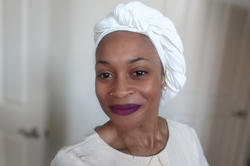Full-time faculty members to join RISD in fall 2021 as a result of the “Race in Art & Design” cluster hire initiative.
Five Questions: Shiraz Abdullahi Gallab

Last year RISD hired a cohort of full-time faculty members focused on race, colonization, decolonization, post-coloniality, cultural representation and material practices of resistance. The educators who joined the community as part of that “Race in Art & Design” cluster hire initiative began teaching at RISD in the fall and have graciously agreed to share their unique pedagogical approaches in this series of Q&As. In this interview, we hear from Graphic Design department faculty member Shiraz Abdullahi Gallab.
Please tell us a little bit about yourself and your areas of academic focus.
I’m a designer who was born in Khartoum, Sudan and raised throughout the United States. I study language, form and specificity in my practice, and I’m also interested in media, Black studies and popular culture. I work in the publishing industry as a book designer and also engage in an independent practice that fuses my deep interest in language with my experience in publishing (and my desire to expand its definition). I’m interested in working with tools and platforms that are accessible and immediately available.

What attracted you to RISD?
The students who have been organizing and advocating for change definitely caught my attention, including and especially the students who created The Room of Silence (Eloise Sherrid 16 FAV, Olivia Stephens 17 IL, Utē Petit 18 ID/TX, Chantal Feitosa 18 FAV, et al.), which I first saw when I was teaching in California six or seven years ago. A growing number of people are invested in seeing a widespread cultural shift at RISD, and the work that has led up to the Schiller Family professorship—stewarded by an incredible group of students, faculty and staff—remains on my mind.
“A growing number of people are invested in seeing a widespread cultural shift at RISD.”
Can you tell me about your 2021–22 courses? How does your personal research/creative practice play into your teaching?
I have been teaching courses on typography, narrative, language, form and gathering this year. In most—maybe all—of my classes, I encourage students to experiment and examine their processes. I see this as a pathway to locating one’s voice and negotiating structure with autonomy.

When examining process, we can approach parameters and conventions as malleable and worth challenging, breaking apart and rebuilding. We can engage in our intuitive gestures and vocabularies as sources of content that connect to our chosen methods of publishing and distributing work.
When graphic design is understood in this way, we can look to poets and artists like M. NourbeSe Philip and Sun Ra as reference points for our students and ourselves. This not only expands our understanding of graphic design’s cultural and creative impact but also makes the discipline more relatable to people of color.
What challenges and opportunities do you face teaching through the lens of decoloniality?
I tend to collaborate across disciplines and institutions when writing course material, and this challenges me to move away from my comfort zone and consider methods that are disruptive and unconventional. My department has been very supportive of this, supplying me with opportunities to cultivate new and existing relationships with educators who have worked closely with me on coordinating workshops, lectures and assignments.
“When examining process, we can approach parameters and conventions as malleable and worth challenging, breaking apart and rebuilding.”
I am also in the early stages of conducting research on Black publishing in the 20th century—beginning with a broad survey of publishers and publications from this time period and, over time, building a reference library for educators and students. The main challenge here is in how this work will be engaged with, understood and protected.
Particularly at RISD, we need to approach Black publishing as a core framework rather than a surface-level addition to the Graphic Design department’s curriculum. We need to situate graphic design within the context of social and historical movements and ask ourselves how this particular context challenges our understanding of graphic design as a professional discipline and practice. And we need to remind ourselves of the original context of this work: who it was intended for and why.

What’s the most important thing you hope students will learn in your classes?
That their thoughts, ideas and suggestions drive our discussions and contribute to the culture of our shared learning environment. I try to avoid positioning myself as a central authority figure and instead aim to facilitate discussions that are prompted by my students’ contributions. I’m really interested in this exchange, in the dialogue between student and teacher and the ways in which we can continually learn from each other, and unlearn, too. There is a fluidity to this exchange, which offers students the agency to shape their experiences in the classroom and remain flexible to changes in perspective.
“I’m really interested in the dialogue between student and teacher and the ways in which we can continually learn from each other, and unlearn, too.”
I took this approach when advising the students who co-led, curated and designed the Black Biennial this past spring: Rey Londres 22 PH, Melaine Ferdinand-King, Zoë Pulley MFA 23 GD, Jada Akoto 22 GD and Nailah Golden 21 GD. I spent the bulk of my time listening to the students, coordinating meetings accordingly, and giving them the space and time needed to pursue their beautiful vision. In doing all of this, our roles reversed and the hierarchy flattened: the students took the lead and I learned so much from them throughout the process.
—Simone Solondz
Read the whole series and learn more about RISD’s commitments to Social Equity and Inclusion.
June 27, 2022


